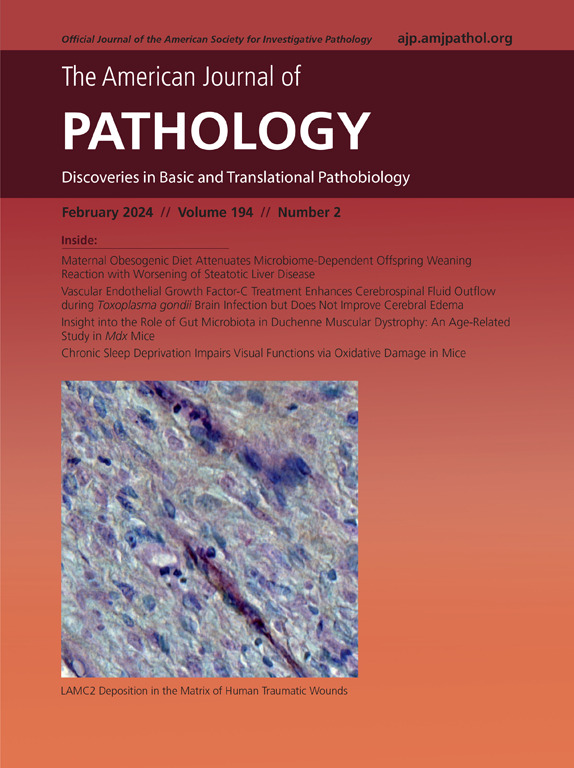Differential Abundance of DNA Damage Sensors and Innate Immune Signaling Proteins in Inositol Polyphosphate 4-Phosphatase Type II–Negative Triple-Negative Breast Cancer Classified by Immunotype
IF 3.6
2区 医学
Q1 PATHOLOGY
引用次数: 0
Abstract
The influence of neoplastic cells on the tumor microenvironment is poorly understood. In this study, eight patient samples representing two immunotypes of triple-negative breast cancer (TNBC), defined by quantitative histologic criteria as T-cell desert and T-cell infiltrated (TCI), were compared via label-free quantitative protein mass spectrometry of material extracted directly from targeted regions of formalin-fixed, paraffin-embedded tissue sections. Of 2934 proteins quantitated, 439 were significantly differentially abundant, among which 361 were overabundant in TCI-TNBC. The 361-protein group included proteins involved in major histocompatibility complex-I antigen processing and presentation, viral defense, DNA damage response, and innate immune signaling. Immunohistochemical validation of selected proteins showed good positive correlation between neoplastic cell histoscores and label-free quantitation. Extension of immunohistochemical analysis to a total of 58 inositol polyphosphate 4-phosphatase type II–negative TNBC confirmed elevated levels of the DNA damage sensor interferon-γ–inducible protein 16, inflammasome adaptor apoptosis-associated speck-like protein containing a CARD (ASC), and pore-forming protein gasdermin D in TCI-TNBC neoplastic cells. By contrast, cGMP-AMP synthase inhibitor barrier to autointegration factor (BAF) was elevated in the neoplastic cells of T-cell desert TNBC. These findings demonstrate a previously unknown correlation between the degree of T-cell infiltration in inositol polyphosphate 4-phosphatase type II–negative TNBC and the levels, in cognate neoplastic cells, of proteins that modulate innate immune signaling in response to DNA damage.

按免疫类型分类的 INPP4B 阴性 TNBC 中 DNA 损伤传感器和先天免疫信号蛋白的丰度差异。
人们对肿瘤细胞对肿瘤微环境的影响知之甚少。在这项研究中,通过对直接从福尔马林固定石蜡包埋组织切片的目标区域提取的材料进行无标记定量(LFQ)蛋白质质谱分析,比较了代表三阴性乳腺癌(TNBC)两种免疫类型的八个患者样本,这两种免疫类型被定量组织学标准定义为T细胞荒漠(TCD)和T细胞浸润(TCI)。在定量分析的 2,934 个蛋白质中,439 个蛋白质的含量存在显著差异,其中 361 个蛋白质在 TCI-TNBC 中含量过高。这361种蛋白质包括参与MHC-I抗原处理和呈递、病毒防御、DNA损伤反应和先天性免疫信号转导的蛋白质。对所选蛋白质进行的免疫组化(IHC)验证显示,肿瘤细胞组织评分与 LFQ 之间存在良好的正相关性。将 IHC 分析扩展到总共 58 个肌醇多磷酸酶 II 型(INPP4B)阴性 TNBC,证实了 TCI-TNBC 肿瘤细胞中 DNA 损伤传感器 IFI16、炎性体适配体 ASC 和孔形成蛋白 GSDMD 水平的升高。相比之下,TCD-TNBC 肿瘤细胞中的环 GMP-AMP 合成酶(cGAS)抑制剂 BAF 水平升高。这些发现表明,在 INPP4B 阴性 TNBC 中,T 细胞浸润程度与同种肿瘤细胞中调节先天性免疫信号以应对 DNA 损伤的蛋白质水平之间存在着一种以前未知的相关性。
本文章由计算机程序翻译,如有差异,请以英文原文为准。
求助全文
约1分钟内获得全文
求助全文
来源期刊
CiteScore
11.40
自引率
0.00%
发文量
178
审稿时长
30 days
期刊介绍:
The American Journal of Pathology, official journal of the American Society for Investigative Pathology, published by Elsevier, Inc., seeks high-quality original research reports, reviews, and commentaries related to the molecular and cellular basis of disease. The editors will consider basic, translational, and clinical investigations that directly address mechanisms of pathogenesis or provide a foundation for future mechanistic inquiries. Examples of such foundational investigations include data mining, identification of biomarkers, molecular pathology, and discovery research. Foundational studies that incorporate deep learning and artificial intelligence are also welcome. High priority is given to studies of human disease and relevant experimental models using molecular, cellular, and organismal approaches.

 求助内容:
求助内容: 应助结果提醒方式:
应助结果提醒方式:


